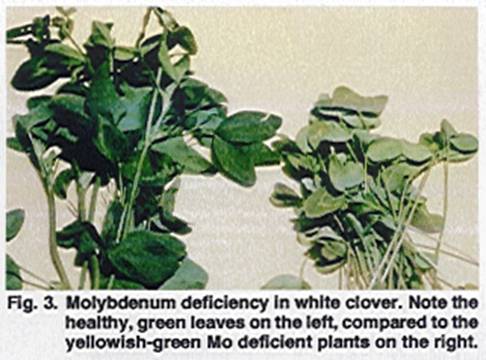Molybdenum (MoO4-)
Functions
Molybdenum is essential for many plant functions. Some of them are
- It functions in converting nitrates (NO3 ) into amino acids within the plant.
- It is essential to the symbiotic nitrogen fixing bacteria in legumes.
- It is essential to the conversion of inorganic P into organic forms in the plant.
Molybdenum is considered to be quite mobile as it moves readily in both the xylem and phloem conductive tissue of the plant. Still its highest concentration is in mature leaves because it binds readily with sulfur-containing amino-groups, sugars, and polyhydroxides which are usually in greater concentration in these leaves. It is found in the enzymes nitrate-reductase and nitrogenase which are essential for nitrate reduction and symbiotic N fixation in plants. Adequate Molybdenum minimizes the presence of nitrites and nitrates in plant tissues.
Factors Affecting Availability
- Leaching Soil Conditions: Available soil Mo is an anion, and is therefore leachable.
- Soil pH: Molybdenum is the only micronutrient that has increased availability as the pH increases. At a soil pH above 6.5, unnecessary Mo applications can result in Mo toxicity to the crop, to animals eating the crop, or it may induce deficiencies of an element listed below. At pH's below 6.0, availability is rapidly diminished because Mo is easily “fixed” in the soil by free Fe(OH)3, AI(OH) 3 and Fe2O3.
- Soil Saturation: It is believed by some researchers that in saturated soils, Mo availability is increased somewhat.
- Mo:S Balance: Some work has shown that sulfate applications can cause a reduction in Mo uptake by plants.
- Mo:P Balance: Applications of P have increased the Mo content of plants in some research. It is thought that P reduces the adsorption of Mo compounds in the soil.
- NH4:NO3 Balance: Plants can often grow well in low Mo soils when fertilized with NH4 fertilizers, as opposed to NO3 fertilizers.
High Response Crops
While this is an essential element for all plants, these crops have been found to be especially responsive.
Alfalfa, broccoli, brussel sprouts, cabbage, cauliflower, clover, lettuce, peas, soybeans, spinach, sugarbeets, tomatoes, tobacco and most legumes.
Deficiency Symptoms
- Chlorosis of leaf margins, or more general chlorosis in some cases whiptail of leaves
- distorted curding of cauliflower
- fired margin and deformation of leaves due to excess NO3
- destruction of embryonic tissue.
- Poor grain or fruit set, due to less viable pollen
Foliar deficiency symptoms are somewhat rare and positive responses may occur where there are no visible symptoms. The most common visible symptom is a pale yellowing resembling nitrogen deficiency. Other symptoms include whiptail of leaves and distorted curding in cauliflower and destruction of embryonic tissue in some legumes.
Toxicity Symptoms
Marginal leaf scorch and abscission as found in typical salt damage. Yellowing or browning of leaves and depressed tillering. Excess levels in plants are more of a concern to animal life, especially ruminants. Over-consumption of plant tissue high in Molybdenum can lead to a condition called Molybdenosis. Because of the intensity of interactions, toxic symptoms will normally manifest themselves as deficiencies of other nutrients (usually Cu). The application of sulfur can decrease Molybdenum uptake and minimize the incidence of toxicity.
Using Molybdenum in a Fertility Program
Most analytic laboratories presently, do not offer soil analysis for Molybdenum on a routine basis. The more capable labs may offer it as a special request. Most soil analytic techniques lack well calibrated interpretive methodology (the correlation between extractable Mo and crop response is the weakest of all the essential nutrients). Plant analyses are a better choice. But, because of limited research the “sufficiency range” in plants is quite broad and not very well defined. Generally speaking values of over 1.0 ppm are considered adequate. However, the crops previously listed will often respond to Molybdenum applications where the soil pH is below 6.2. As stated earlier, be very careful with Molybdenum applications at pH's above 6.5, as yield reductions can occur.
Typical Application Rates (of sodium molybdate, not elemental Mo)
| Method | Rate |
|---|---|
| Broadcast | 6 to 12 oz./Acre |
| Foliar | 1 to 3 oz./Acre |
| Seed Treatment | 0.5 to 1 oz./Acre |
The seed treatment is preferred with direct seeding. However, foliar application is favored for transplants. Broadcast applications for transplants are effective only where the soil pH is above 5.6.
Some common fertilizer products containing molybdenum include:
| Product | Chemical Formula | Typical Mo Content |
|---|---|---|
| Sodium Molybdate | Na2MoO4⋅2H2O | 39% |
| Molybdenum Trioxide | MoO3 | 66% |
| Ammonium Molybdate | (NH4)6Mo7O24⋅2H2O | 54% |

No comments:
Post a Comment